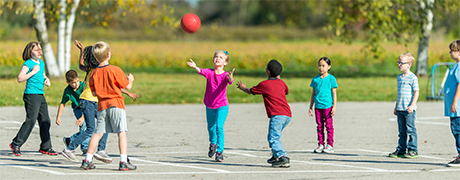Physical Activity & Recess

Physical Activity
Schools are an ideal setting for teaching youth how to adopt and maintain a healthy active lifestyle.
Learn about the role of schools in increasing physical activity.
Physically active students are better prepared for school and for life. Research shows that physical activity benefits children’s physical, mental and cognitive health. It affects perception, memory, judgment, focus and reasoning. It increases scores on verbal and mathematics tests and overall academic performance. Regular physical activity also decreases the risk of obesity-related risk factors such as type 2 diabetes and heart disease. Physical activity increases social skills, encourages an active lifestyle, and helps students focus better in the classroom throughout the school day.
The Physical Activity Guidelines for Americans, issued by the U.S. Department of Health and Human Services, recommend that children and adolescents aged 6-17 years should have 60 minutes (1 hour) or more of physical activity each day. Physical activity includes recess, physical education, in-classroom activities, school-wide activities, open gym before and after school and intramural sports.
In-classroom physical activities are a great way to get students’ minds moving and refreshed during class time. Teachers can integrate physical activity in between or into lessons. Even a 3 minute activity can increase mental alertness and focus.
The Alaska State Legislature passed the
Alaska Physical Activity in Schools Law in April 2016 which states school districts shall establish guidelines to provide opportunities for 54 minutes of physical activity each full school day for students in grades K-8.
Recess
Recess provides students with a needed break from their structured school day. Safe and supervised recess provides opportunities for children to learn important socio-emotional skills such as valuable communication skills, cooperation, and negotiation. As with any type of physical activity, recess enhances academic performance and student focus.
The Centers for Disease Control and the American Academy of Pediatrics recommend that schools provide at least 20 minutes of daily recess for all elementary students.
Recess can be structured or unstructured, benefits are derived from both. Recess can be offered more than once a day and any time of the day.
Recess Before Lunch is one option that improves lunch time behavior and reduces food waste.
Recess should never be withheld as punishment for behavior or academic performance. Recess helps improve both behavior and academic performance; therefore schools are encouraged to
consider using one or more of many discipline alternatives.
Resources
Publications older than 25 months can be found on the
State
of Alaska Library Archives website.